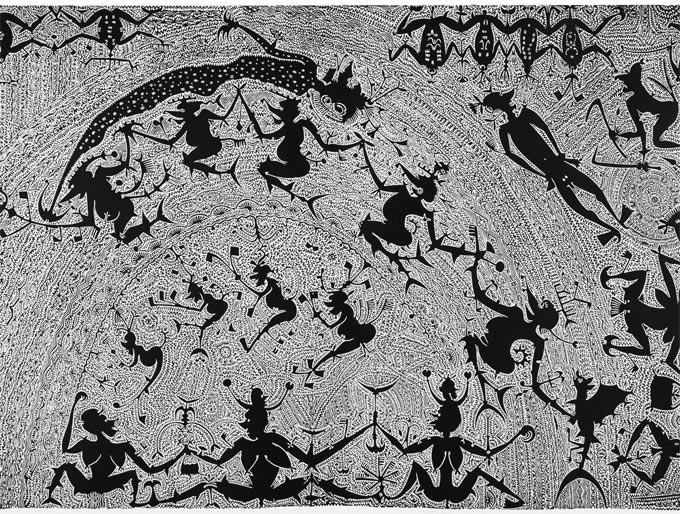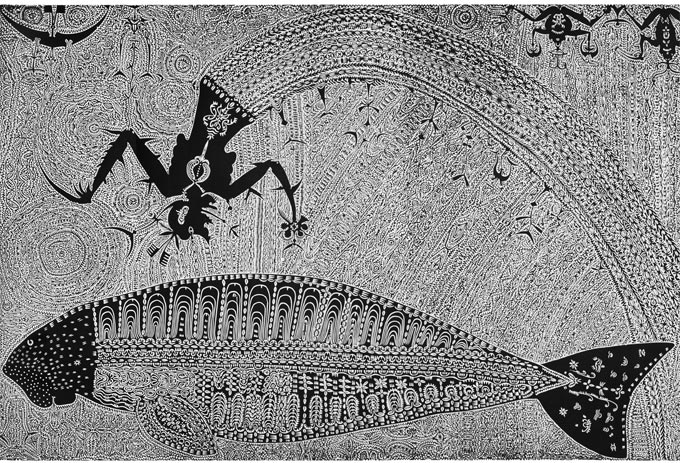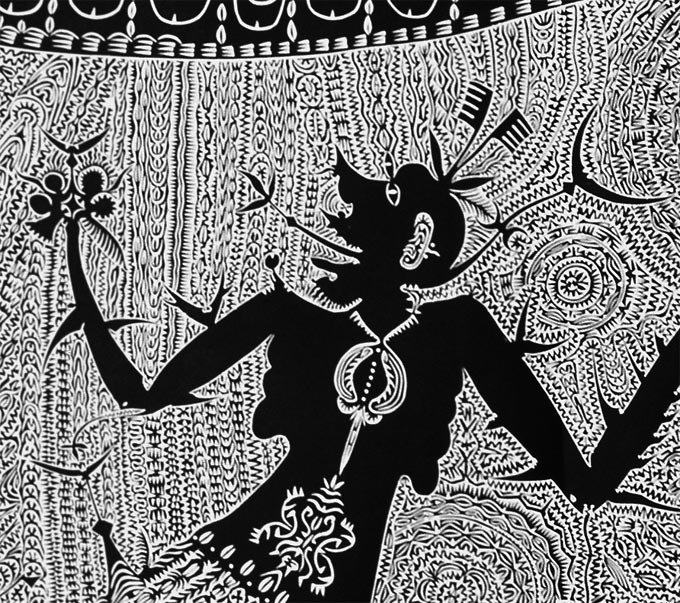Dennis NONA
Yawarr , 2007
Art : Aboriginal
Origine : Ile de Badu
Dimensions : 610 x 125 cm
Medium : Linocut
Price : Non disponible à la vente / Not available
N° : DN121
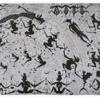
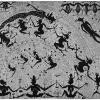
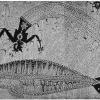
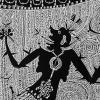
ed./20Yawarr is the central character in the story that tells of how he was transported on rainbows between the Torres Strait Islands of Badu, Nagir, Poruma, Aurid, Masig and Mer.It is also a gardening story that relates to differences between the sizes of the crops on different islands.Yawarr’s travels were forced on him by the Madub or Spirit People who are capable of creating extremely powerful magic.This story belongs to the Wakaid clan of Badu Island and was first related to the artist by his father, Morris Nona. The artist also referenced the Reports of the Cambridge Anthropological Expedition to the Torres Straits which was led by the English anthropologist, Alfred Cort Haddon in 1898.Yawarr lived at a place called Kainply (the burial site where the Badu Island ancestor, Goba was killed).Wabou Pad is the name of the hill where Yawarr made his vegetable garden.Yawarr had three wives. At harvest ceremony time they would pile up the wild yam (saurr), cassava (gabau), taro (manata) and sweet potato (urrgabau) on the ceremonial grounds. When the villagers from Zaum, Bait and Koitade saw Yawarr’s vegetables they were amazed because they were three to four times bigger than the ones they grew.The villagers asked Yawarr to tell them about the magic that made his vegetables so big. He took two men from each village to his garden and showed them his secret which was to place the vegetables in the ground in a special way. When they returned to their village they forgot what they had been shown so they went back and asked Yawarr again. However, they had to wait two to three months for the monsoon season before they could sow their crops. By the time the monsoons came they had forgotten again what Yawarr had told them. The villagers went back to Yawarr but he refused to tell them a third time.Yawarr’s refusal angered the villagers and they sought the help of the Madub people to inflict some magic on Yarwarr in order to punish him.(Madub people or Madubal, are dwarf like spirits who are usually seen in large groups and who lived in the Wakaid clan area on the South East side of Badu at a place called Madubau Kal. They are capable of creating extremely powerful magic).The next morning Yawarr gave each of his three wives two of every vegetable including several types of bush yams, sweet potatoes, cassava, sugar cane (guru) and instructed them to go down to the coast and gather bush berries (wirri wirri, mazaru and wapi) and mud crabs (gurrba) for lunch. When the wives left, he went to his garden at Wabou Pad where he was confronted by the Madubal. They called on the rain and thunder to create a rainbow (curuwai). They surrounded him, brandishing their pui (long rods with hooks on each end) and hooked Yawarr under his arms and rolled him down the hill. They put him in the rainbow and carried him to the neighbouring island of Moa (Banks Island) to a place called Bulbul. There they created a sacred rock, Kula that can still be seen there today. Yawarr protested saying, ‘I did no wrong, I have three wives and children to care for, take me back to Badu.’The Madubal mocked him and created another rainbow to Nagir (Mt Ernest Island) where he was taken. Yawarr insisted he be taken home but was mocked again and taken on another rainbow to Poruma (Coconut Island) by the Madubal. He protested and was mocked yet again and this time taken on a rainbow to Aurid (Aureed Island). Still protesting he was finally transported to the Eastern Island of Mer (Murray Island).Yawarr could not see Badu any longer and the Madubal continued their mocking leaving him on Mer and travelling back to Badu on the rainbows.Yawarr laughed and called after the Madubal saying, ‘you can go back to Badu but I have the best soil and so cursed the Madubal and the Badu Islanders to grow smaller crops than those on Murray Island whose people had been given Yawarr’s magic garden (Upay Pui).When the Madubal returned to Badu they burnt Yawarr’s two houses, took his three wives and children and claimed his cassava and vegetable gardens. Today crops grow in abundance on Murray Island in comparison to those on Badu.The print is a visual narrative that reads from right to left. On the far right the wild yams, banana trees (katam), sugar cane and other vegetables in Yawarr’s garden can be seen. Above the banana trees are the villagers who approached Yawarr to learn his magic. Their heads represent the clan totems of the Island, stingray, crocodile, dugong and dog. Yawarr is seen above the sugar cane with his Pat (digging stick) demonstrating to the two villagers the secret of how he plants his vegetables to make them so big. Yawarr’s three wives can be seen below with the vegetables and mud crabs they used to make lunch. They are holding coconut baskets (eiuw).Above this section of the print are three Madub people approaching Yawarr with their Pui (hooked sticks) that they used to roll him down the hillside.The three groups of frogs at the top of the print represent the rain that allowed the Madubal to create the rainbows they used to transport Yawarr from island to island. Five Madub people can be seen carrying Yawarrr on the rainbow. The bat like figure linked to these five signify the powerful magic that they and other sorcerers can create to enable them to fly from island to island The four smaller figures below are the Madubau Mariel who are ancestors of the Madubal and are the ones who are the source of the magic they possess. Below this are Yawarr’s three wives that the Madubal took on their return to Badu after having left Yawarr on Mer.The left hand side of the print shows Yawarr arriving at Mer on the rainbow. The island of Mer is the shape of a dugong and takes that form because of another ancient legend in which an ancestor called Gelam travelled from Moa Island in a wooden dugong that became the Island of Mer. The village is on the tail side and the main waterhole is located around the nostril area of the dugong. The patterning in the body of the dugong depicts the orderly and prolific vegetable gardens that Yawarr made and he gave to the Murray Island people.

